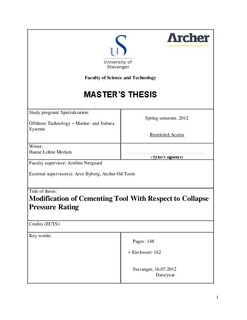| dc.contributor.author | Morken, Hanne Lohne | |
| dc.date.accessioned | 2014-02-06T09:01:09Z | |
| dc.date.available | 2014-02-06T09:01:09Z | |
| dc.date.issued | 2014 | |
| dc.identifier.citation | Konf. til juli 2014 | no_NO |
| dc.identifier.uri | http://hdl.handle.net/11250/183150 | |
| dc.description | Master's thesis in Offshore Technology - Marine and Subsea Technology | no_NO |
| dc.description.abstract | The intention for this project was to increase the collapse pressure rating for the C-Flex SS 9 5/8” by modifying the design. This project started by evaluating the existing design. This was done before the modification of the C-Flex SS 9 5/8” design was implemented. Two design alternatives were made. In the first design alternative there are placed to seals at the opposite side of the threads compared to the position of the seal in existing design. This position of the seals will prevent the threaded connection from being pressurized when the tool is exposed to collapse pressure. In the second design alternative two seals are positioned at the same side of the threads as for the existing design. The difference is that in this design there are two seals. In this design the threaded connection between the end coupling and the housing will be pressurized when the tool is exposed to collapse pressure. Calculations and analyses were made for both design alternatives. These were used to check whether the designs gave satisfying results or if some additional adjustments had to be made. Calculations and analyses for the existing design and for the two design alternatives were compared. The comparison indicated that the first design alternative would have the highest sealing capacity. When the design alternatives gave satisfying results the pressure test equipment was designed. The pressure test equipment was designed based on pressure test performed with gas. Analyses and calculations were made for the pressure test equipment to check the capacity. After the delivery of all the equipment it was assembled and prepared for collapse pressure test. The collapse pressure tests were performed with gas at IRIS in Stavanger. Maximum pressure for the test was 89.5 MPa. At 89.5 MPa there would be a tensile force of 2926 kN in the test piece for both design alternatives. No leakage was detected for the first design alternative. The test of the second design alternative failed at 79 MPa due to burst of test equipment. The burst is assumed to have been caused by collapse of the end coupling. Further investigation is necessary to determine this. The sealing capacity is better for the first design alternative than for the existing design when exposed to collapse pressure and tensile force. It is determined that the first design alternative will be implemented in the C-Flex SS portfolio for new C-Flex SS designs. | no_NO |
| dc.description.sponsorship | Archer Oil Tools AS | no_NO |
| dc.language.iso | eng | no_NO |
| dc.publisher | University of Stavanger, Norway | no_NO |
| dc.relation.ispartofseries | Masteroppgave/UIS-TN-IKM/2012; | |
| dc.subject | design modification | no_NO |
| dc.subject | mechanical engineering | no_NO |
| dc.subject | multistage cementing collar | no_NO |
| dc.subject | offshore teknologi | no_NO |
| dc.subject | undervannsteknologi | no_NO |
| dc.title | Modification of cementing tool with respect to collapse pressure rating | no_NO |
| dc.type | Master thesis | no_NO |
| dc.subject.nsi | VDP::Technology: 500::Marine technology: 580 | no_NO |
